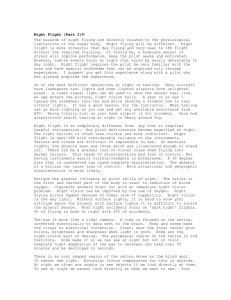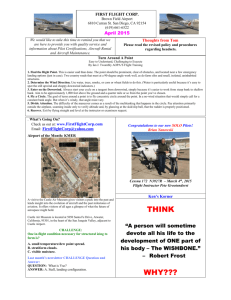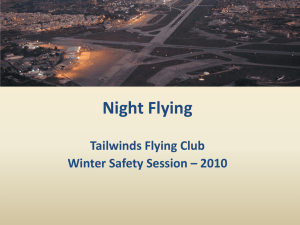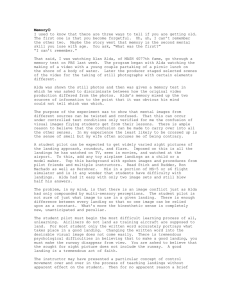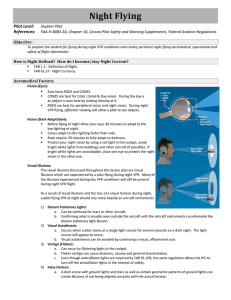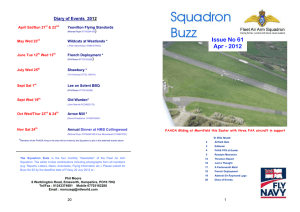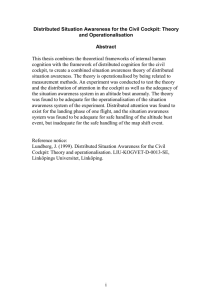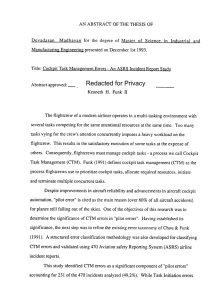Night Flight (Part 2)
advertisement
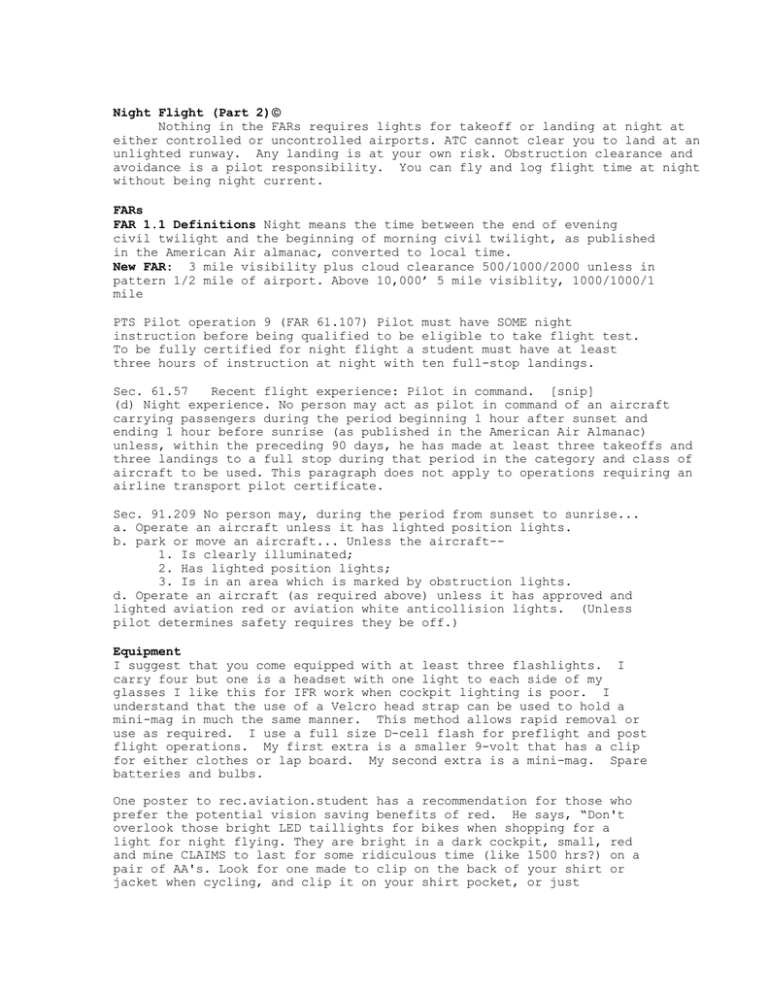
Night Flight (Part 2) Nothing in the FARs requires lights for takeoff or landing at night at either controlled or uncontrolled airports. ATC cannot clear you to land at an unlighted runway. Any landing is at your own risk. Obstruction clearance and avoidance is a pilot responsibility. You can fly and log flight time at night without being night current. FARs FAR 1.1 Definitions Night means the time between the end of evening civil twilight and the beginning of morning civil twilight, as published in the American Air almanac, converted to local time. New FAR: 3 mile visibility plus cloud clearance 500/1000/2000 unless in pattern 1/2 mile of airport. Above 10,000’ 5 mile visiblity, 1000/1000/1 mile PTS Pilot operation 9 (FAR 61.107) Pilot instruction before being qualified to be To be fully certified for night flight a three hours of instruction at night with must have SOME night eligible to take flight test. student must have at least ten full-stop landings. Sec. 61.57 Recent flight experience: Pilot in command. [snip] (d) Night experience. No person may act as pilot in command of an aircraft carrying passengers during the period beginning 1 hour after sunset and ending 1 hour before sunrise (as published in the American Air Almanac) unless, within the preceding 90 days, he has made at least three takeoffs and three landings to a full stop during that period in the category and class of aircraft to be used. This paragraph does not apply to operations requiring an airline transport pilot certificate. Sec. 91.209 No person may, during the period from sunset to sunrise... a. Operate an aircraft unless it has lighted position lights. b. park or move an aircraft... Unless the aircraft-1. Is clearly illuminated; 2. Has lighted position lights; 3. Is in an area which is marked by obstruction lights. d. Operate an aircraft (as required above) unless it has approved and lighted aviation red or aviation white anticollision lights. (Unless pilot determines safety requires they be off.) Equipment I suggest that you come equipped with at least three flashlights. I carry four but one is a headset with one light to each side of my glasses I like this for IFR work when cockpit lighting is poor. I understand that the use of a Velcro head strap can be used to hold a mini-mag in much the same manner. This method allows rapid removal or use as required. I use a full size D-cell flash for preflight and post flight operations. My first extra is a smaller 9-volt that has a clip for either clothes or lap board. My second extra is a mini-mag. Spare batteries and bulbs. One poster to rec.aviation.student has a recommendation for those who prefer the potential vision saving benefits of red. He says, “Don't overlook those bright LED taillights for bikes when shopping for a light for night flying. They are bright in a dark cockpit, small, red and mine CLAIMS to last for some ridiculous time (like 1500 hrs?) on a pair of AA's. Look for one made to clip on the back of your shirt or jacket when cycling, and clip it on your shirt pocket, or just hold it in the palm of your hand when flying. Works great, costs $15-20, batteries included...” I haven’t tried it. but in the poor lighting of older aircraft it sounds like a great idea. At night you don’t want to run out of writing instruments. I loop rubber bands together and hang pens on the yoke, clipboard, and someplace else. These are in addition to the ones in my pocket and under by watch band. You don’t ever want to get caught without a pen at night. Preparation You should review the physiology of night vision so as to better understand the operation of the eye. Over age 40, fatigue, and smoking affect visual acuity and adaptation to darkness. Do not look directly at an object at night because the optic nerve location may not let you see it. The decrease in oxygen above 4000' decreases visual efficiency. The Air Force requires full oxygen from the surface at night. The light smoker is physiologically at 3000' before he gets into the plane. Above 8000' at night it is a good idea to have oxygen. Since we don't see as well as might be desired at night we must compensate using experience (brains) and technology. Before I stopped teaching smokers to fly, I would take my oxygen kit on my longer night flights. I would have the smoker use a coffin nail just before getting into the plane. We would climb to 8000’ and I would have him use oxygen. Invariably they would remark that lights all over the area had been suddenly turned on. This night flight along with recognition of the other health hazards made all of my students give up smoking. I can emphasize with smokers trying to quit. I gave up coffee last December and was able to drop my blood pressure 10 points. It’s tough to do unless you are properly motivated. Any bright light effectively reduces night vision. Even the white flash of a rotating beacon is capable of destroying your preserved night vision. You might try protecting one eye from light until airborne. Try wearing sunglasses at dusk. My personal preference is to use full white cockpit lighting and rely on airport lighting for landing and taxiing. A listing of areas that require preparation beyond that which is considered appropriate for day flights would be. When you fly at night you should prepare by: 1. Being able to hand draw your approach and departure routes from the airports to be used. 2. Being able to hand draw your taxi routes regardless of the kinds of landing planned. 3. Becoming aware of the many illusions that occur at night you will see the necessity of (1) and (2) above. Causes of vertigo and disorientation. 4. Making an honest assessment of current skills, and familiarity with the aircraft with emphasis on fuel reserves and shorter range limits. Biological clock and fatigue factors must be considered. 5. Making a route study of terrain heights, obstruction heights, minimum safe altitudes with night flight safety margins, airport information, and frequencies for com and nav. Checkpoints based on night conditions 7. Making a weather study of moon phase, cloud conditions, dew point spread, freezing level, and visibility. Where cloud decks may exist consider possibilities of over flying or under flying cloud cover and the hazards incurred thereby. 8. Comparing the new FAR requirements with forecast weather conditions. 9. Taking a blindfold test of the cockpit switches and controls. 10. Cockpit organized with charts in order and folded for use. an flashlights along with spare batteries. 11. Emergency alternatives including non-electronic options. options for diversion. Pens Airport 12. Familiar and unfamiliar airport preparation including phone contact for local procedures and advice. Planned fuel stops at FBOs and credit card pumps. When towers close you can expect to find left hand traffic to right runways, but not every time. 13. Referral to the Airport/Facilities Directory to determine airport lighting changes, operational procedures, critical information, and cautions.
